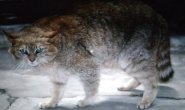 The Chinese Mountain Cat (Felis bieti) or Chinese Desert Cat as it was known before 1992, had its name changed in Bejing (1992) by Chinese specialists, who argued that cats seen in the desert were misidentified Asian wildcats and not Felis bieti. They have been reported living in the Daban and Datong mountains near Xining, at elevations ranging from 2800 m to 4100 m. The Chinese Mountain Cat has been surviving in one of the most difficult environments found in the world.
The Chinese Mountain Cat (Felis bieti) or Chinese Desert Cat as it was known before 1992, had its name changed in Bejing (1992) by Chinese specialists, who argued that cats seen in the desert were misidentified Asian wildcats and not Felis bieti. They have been reported living in the Daban and Datong mountains near Xining, at elevations ranging from 2800 m to 4100 m. The Chinese Mountain Cat has been surviving in one of the most difficult environments found in the world. Also called the 'Chinese Grey cat', the Chinese Mountain Cat is of stocky physique, a little bit larger than a domestic cat, with short legs. Usually, the color is light gray (fawn) during wintertime, and would turn to a darker hue during the summer. Chinese Mountain Cat's ears are of light red-brown, with tips of short hair tufts. The pelts of Chinese Mountain Cats make appearances at the markets, although they are fully protected by the Chinese government.
A Chinese Mountain Cat is basically crepuscular (active during twilight) and nocturnal, they hunt in the dawn hours and late night time. The reproduction period of these cats runs from January to March and the female Chinese Mountain Cat attends to the newborns in burrows, with just one entrance. They have lost a great part of their habitat, and their kind is now among the most endangered cats on the face of the earth.
Their diet consists of rabbits, rats and birds (also pheasants). The majority of the rodents they catch are pikas, white tailed pine voles and mole rats,
Interesting fact: Chinese mountain cats are not social animals and the females and the males live apart from each other.
Link: On august 2007, National Geographic caught the Chinese Mountain Cat on camera in the wild
The Chinese desert cat, chinese mountain cat is listed as Vulnerable (VU), considered to be facing a high risk of extinction in the wild, on the IUCN Red List of Threatened Species
Namings for the Chinese desert cat
A young / baby of a Chinese desert cat is called a 'kitten'. The females are called 'queen' and males 'tom '. A Chinese desert cat group is called a 'clowder, clutter, pounce, kindle (young), embarrassment (young),'.Countries
China
Custom Search